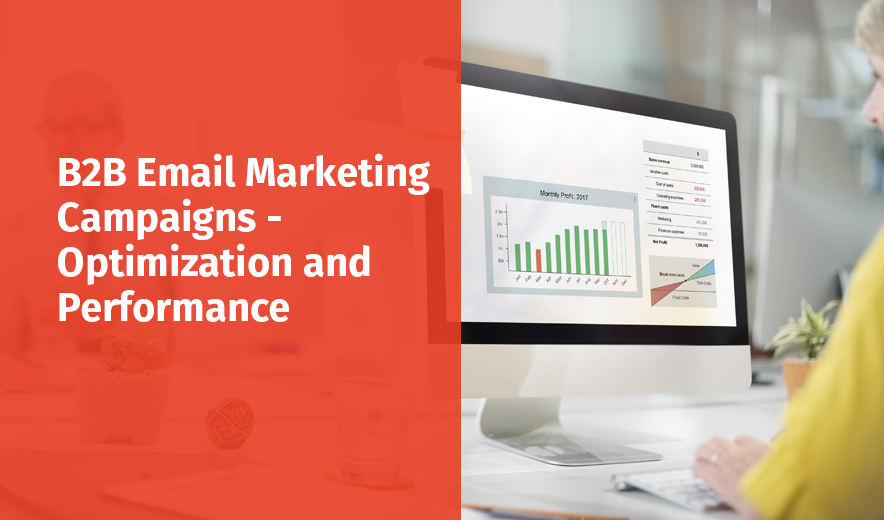Email marketing serves a crucial role in B2B (business-to-business) campaigns, playing a pivotal role in establishing and fostering relationships, engaging key stakeholders, and ultimately driving lead generation and revenue. Its significance lies in its unique capabilities to directly communicate with a targeted B2B audience, providing a valuable channel for businesses to reach decision-makers and influencers in their target market.
One primary function of B2B email marketing is lead generation through strategies like gated content, webinars, and whitepapers, nurturing these leads through the sales funnel.
Email marketing offers a cost-effective means of communication compared to traditional marketing channels. Its affordability makes it particularly attractive to B2B companies, especially those operating within budget constraints. The ability to segment email lists based on criteria such as industry, job role, or company size enhances the targeting precision, allowing businesses to tailor their messages to specific audience segments.
The analytics and measurement capabilities of email marketing platforms provide valuable insights into campaign performance, including metrics like open rates, click-through rates, and conversion rates.”
Automation tools are another key feature of B2B email marketing, enhancing efficiency by allowing the setup. of automated workflows. These workflows deliver targeted content based on user behavior, ensuring prospects receive timely and relevant information, fostering consistent communication and engagement.
Additionally, B2B email marketing complements content strategies by promoting blog posts, whitepapers, case studies, and managing event registrations, especially for webinars and conferences.
Consistent branding and messaging through email marketing build brand awareness and trust, reinforcing the company’s market position.
The central role of email marketing in B2B campaigns stems from its ability to facilitate direct communication, drive lead generation, nurture relationships, offer cost-effective solutions, enable targeted outreach, provide robust analytics, and enhance overall campaign efficiency. When executed strategically, B2B email marketing significantly contributes to marketing and sales success in the business-to-business sector.
Optimizing Email Content Strategies
Compelling Subject Lines: Craft attention-grabbing, concise, and relevant subject lines. Personalization, urgency, and curiosity can be effective elements. A/B testing different subject lines can help identify the most engaging ones.
Clear and Relevant Content: Ensure email content is clear, concise, and directly addresses recipient needs or pain points. Use engaging language to deliver value. Segment your audience for more personalized content catering to specific interests.
Personalization: Leverage personalization by including the recipient’s name and tailoring content based on their preferences or past interactions. Dynamic content that adapts to user behavior enhances the personal touch.
Effective Call-to-Actions (CTAs): Make CTAs clear, compelling, and action-oriented. Experiment with button colors, sizes, and text to resonate best with your audience. Use persuasive language to encourage clicks.
Mobile Optimization: Ensure email content is optimized for various devices. Use responsive design for a seamless experience. Keep content concise for quick consumption.
Visual Appeal:Include visually appealing elements such as images and graphics. Balance visuals with text for a clean, professional look. A/B test different visual elements to understand audience preferences.
Segmentation and Targeting: Segment email lists based on demographics, behavior, or preferences. Targeted content aligns with specific segment needs, increasing relevance and engagement.
Social Proof and Trust Signals: Include testimonials, reviews, or certifications to build trust and enhance credibility.
Impact of Content Tweaks on Open and Click-Through Rates
The impact of content tweaks on open and click-through rates varies based on audience preferences, industry, and content nature. Employing A/B testing is crucial to measure these impacts:
Subject Lines: A/B testing different subject lines can reveal higher open rates. Personalization may lead to a 15% increase compared to generic lines.
CTAs: Experimenting with different CTAs might increase click-through rates by 10%. Adjusting button colors could result in a 5% improvement.
Personalization: Personalized content may contribute to a 20% increase in click-through rates. Tailoring content based on past interactions might result in a 12% improvement in engagement.
Visual Elements:Including relevant images or graphics may lead to a 7% increase in click-through rates.
Segmentation and Targeting: Segmentation based on industry may result in a 25% increase in engagement within specific sectors. Targeting different demographics could lead to a 10% improvement in click-through rates.
Optimizing email content involves a blend of effective strategies such as compelling subject lines, clear content, personalization, and persuasive CTAs. A/B testing these tweaks provides valuable insights to refine future campaigns and enhance overall performance.
Segmentation and Targeting
Segmentation and targeting bolster B2B email marketing by enhancing communication precision with business clients:
Relevance and Personalization
Segmentation: Tailoring messages based on industry, company size, or location enhances relevance for each segment.
Targeting: Addressing specific segment pain points increases engagement and conversion likelihood.
Improved Engagement Rates
Segmentation: Dividing the audience into manageable segments boosts engagement by delivering tailored content.
Targeting: Reaching the right audience ensures positive responses to emails.
Enhanced Customer Retention
Enhanced Customer Retention:
Segmentation: Understanding segment needs nurtures long-term relationships, fostering loyalty.
Targeting: Providing personalized solutions strengthens relationships and reduces churn.
Optimized Resource Utilization
Segmentation: Efficient resource allocation by tailoring campaigns prevents unnecessary spending on generic content.
Targeting: Focusing on promising leads enhances cost-effectiveness.
Data-Driven Decision-Making
Segmentation: Analyzing data from segmented campaigns provides valuable insights into the preferences and behaviors of different B2B segments. This information can be used to refine future campaigns and optimize overall marketing strategies.
Targeting: Continuous monitoring of the performance of targeted emails allows for real-time adjustments and improvements based on recipient engagement and conversion metrics.
Segmentation and targeting empower B2B email marketers to deliver more personalized, relevant, and engaging content to specific business segments. This precision leads to higher open rates, increased engagement, improved customer retention, and ultimately, a more successful B2B email marketing campaign.
A/B Testing and Iteration
A/B testing and data-driven iteration are essential components of successful email marketing campaigns, allowing marketers to refine and optimize their strategies based on real-world performance metrics. Here’s why these practices are important and how they contribute to improved email campaign outcomes
Importance of A/B Testing and Data-Driven Iteration
Optimizing Campaign Elements
A/B Testing: By testing variations of specific elements (e.g., subject lines, CTAs, images, or copy), marketers can identify which version performs better. This insight helps in refining and optimizing these elements for maximum impact.
Iteration: Data-driven iteration involves using the results of A/B tests to make informed adjustments. This continuous improvement process ensures that each element of an email campaign is optimized over time.
Understanding Audience Preferences
A/B Testing: Marketers can experiment with different content formats and styles to understand what resonates best with their audience. This includes testing variations in tone, length, and visual elements.
Iteration: Analyzing A/B test results provides valuable insights into audience preferences. Marketers can then iterate on their content strategy, tailoring future emails to better align with what their audience finds most engaging.
Enhancing Personalization
A/B Testing: Personalization is a key driver of email engagement. A/B tests can be used to experiment with different levels of personalization, such as using the recipient’s name in the subject line or tailoring content based on past interactions.
Iteration: Based on A/B test results, marketers can refine their personalization strategies, ensuring that emails are not only personalized but also resonate more effectively with the target audience.
Optimizing Timing and Frequency
A/B Testing: Testing different send times and frequencies helps identify the optimal schedule for reaching the target audience. This can include testing the impact of sending emails on different days of the week or at different times.
Iteration: Continuous iteration based on A/B test results allows marketers to adjust the timing and frequency of their emails, ensuring they are delivered when recipients are most likely to engage.
Examples of A/B Tests Leading to Improved Email Performance
Subject Line Testing
A/B Test: Two variations of a subject line are tested – one emphasizing urgency and the other highlighting a benefit.
Result: The urgent subject line leads to a higher open rate, indicating that the audience responds more positively to a sense of urgency.
CTA Button Color Testing
A/B Test: Two versions of an email are sent with different colors for the call-to-action (CTA) button.
Result: The email with the red CTA button outperforms the one with the green button, suggesting that the audience is more responsive to the red color.
Content-Length Testing
A/B Test: Two versions of an email are created, one with concise content and the other with a longer, more detailed message.
Result: The shorter email receives a higher click-through rate, indicating that the audience prefers concise and to-the-point content.
Image vs. Text-Only Testing
A/B Test: One version of an email includes a visually appealing image, while the other is a text-only format.
Result: The image-based email leads to higher engagement, suggesting that visuals play a significant role in capturing the audience’s attention.
A/B testing and data-driven iteration are integral to the success of email campaigns. They provide valuable insights into audience behavior, preferences, and responsiveness, allowing marketers to continuously refine and optimize their email marketing strategies for better performance and higher ROI.
In conclusion, B2B email marketing stands as a cornerstone in contemporary business strategies, by leveraging the power to establish connections, engage key stakeholders, and propel lead generation and revenue. Email offers a cost-effective marketing channel with advanced capabilities such as robust analytics and automation capabilities.
Well-planned email strategies can ensure compelling subject lines, clear and relevant email copies, personalized offers, and CTAs, mobile optimization, visual appeal, and strategic segmentation and targeting that results in successful B2B email campaigns.
The impact of subtle content tweaks on open and click-through rates underscores the importance of continuous improvement. A/B testing is a valuable ally, allowing marketers to refine and optimize various elements, including subject lines, CTAs, personalization, visual elements, and segmentation strategies. These adjustments, driven by data-driven insights, hold the key to unlocking higher engagement and conversion rates.
Segmentation and targeting, fundamental to B2B email marketing, enable precision and personalization, enhancing relevance and engagement. The power of these strategies extends beyond improved open and click-through rates, contributing to enhanced customer retention, optimized resource utilization, and data-driven decision-making.
A/B testing and data-driven iteration emerge as crucial practices in the arsenal of email marketers. By consistently testing and refining elements based on real-world performance, marketers can optimize campaign elements, understand audience preferences, enhance personalization, and fine-tune the timing and frequency of email communications. The presented examples of A/B tests leading to improved email performance further emphasize the effectiveness of these practices in tailoring strategies to the unique preferences and behaviors of the target audience.
In essence, the success of B2B email marketing lies not only in its inherent capabilities but also in the strategic and iterative approach adopted by marketers. As businesses navigate the evolving landscape of digital communication, a commitment to optimization, personalization, and data-driven decision-making ensures that B2B email campaigns remain not just relevant but impactful in driving business success.
Be a part of our community for free and access the best resources, trends, and new technologies from peers and industry experts. You can also check out our other awesome blogs over here.





